Servicios Personalizados
Revista
Articulo
Indicadores
-
 Citado por SciELO
Citado por SciELO -
 Accesos
Accesos
Links relacionados
-
 Similares en
SciELO
Similares en
SciELO
Compartir
Psicologia
versión impresa ISSN 0874-2049
Psicologia vol.11 no.1 Lisboa ene. 1996
https://doi.org/10.17575/rpsicol.v11i1.588
Towards the resolution of the apparent discrepancy between the incongruency effecte and expectancy. Based illusory correlations
Leonel Garcia-Marques*
*Faculdade de Psicologia e de Ciências da Educação Universidade de Lisboa
ABSTRACT
Two of the most reliable effects of Social Cognition, the incongruency effect and the expectancy-based illusory correlation are apparently incompatible. The incompatibility seems even more acute, if the similarity of the conditions where these effects have, typically, been obtained is taken into account. There were however but a few conceptual attempts at the resolution of this apparent paradox. To make things worst, even these attempts have neither produced a desirable unifying framework or been able to completely account for the full pattern of known results. The author presents a new framework, the Generalized Hastie-Srull (GHS) Model which constitutes an effort to overcome this unfortunate State of aífairs. Also a new experimental paradigm that combines the typical features of the two original experimental paradigms is also presented, together with the results of the first studies that have used it. These results, showing a dissociation between free recall and the estimation of the frequency of expectancy-incongruent information, provide strong reasons to dismiss the paradox. The broad implications of this work to our understanding of impression formation processes are also addressed.
RESUMO
Dois dos mais robustos efeitos da Cognição Social, o efeito de incongruência e as correlações ilusórias baseadas nas expectativas, são aparentemente incompatíveis. Esta incompatibilidade torna-se mais aguda se for levada em consideração a similitude entre os contextos experimentais em que, tipicamente, se encontram ambos os efeitos. Não tem existido contudo senão um pequeno número de tentativas conceptuais de resolução deste aparente paradoxo. E pior, mesmo essas tentativas não produziram nem um desejável enquadramento global, nem foram capazes de abarcar completamente os dados disponíveis. O autor apresenta um novo enquadramento teórico, o modelo «Generalização de Hastie-Srall» (GHS), que representa um esforço de ultrapassar esta situação. Um novo paradigma experimental que combina as características típicas dos dois paradigmas experimentais originais, é também apresentado, concomitantemente com os resultados dos primeiros estudos que o utilizaram. Os resultados, mostrando uma forte dissociação entre a evocação livre e a estimação da frequência da informação incongruente com as expectativas, fornecem fortes razões para a dissolução do paradoxo referido. São igualmente discutidas as implicações mais latas destes estudo para a compreensão dos processos de formação de impressões.
Introdution
Even with the benefit of hindsight and after more than 10 years, Hastie and Kumar’s results (Hastie & Kumar, 1979) can still strike us as mind-boggling. In fact, the better recall of expectancy-incongruent information relatively to expectancy congruent or neutral information (that is, the incongruency effect) was too unexpected. The reasons for this unexpectedness lie, of course, in the convergent support that had been accumulating for the view of the social perceiver as someone with a very distinct aversion for dissonance (Festinger, 1957), belief or stereotype change (Allport, 1954; Hamilton & Rose, 1980), impression revision (Anderson & Hubert, 1963; Asch, 1946), hypotheses disconfirmation (Bruner & Potter, 1964; Mynatt, Doherty & Tweeney, 1977; Wason & Johnson-Laird, 1972) or information unrelated to an activated schema (Rummelhart & Ortony, 1977).
Nevertheless, expected or not, the incongruency effect is now quite respectable, robust, reasonably well documented and delimited (for reviews see Higgins & Bargh, 1987; Rojahn & Pettigrew, 1992; Srull & Wyer, 1989; Stangor & McMillan, 1992; Wyer, 1989; Wyer & Srull, 1986, 1989). This fact alone made conceptual attempts to reconcile the incongruency effect with the several «congruency biases» just referred to (e.g., belief perseverance, confirmation bias or schema filter) almost unavoidable. Unfortunately these efforts have not been completely successful in achieving the desired reconciliation (see Crocker, & Hannah & Weber, 1983; Fiske & Neuberg, 1990; Higgins & Bargh, 1987; Stangor and Ruble 1989; for a detailed critique, see Garcia-Marques, 1993).
In this paper a new attempt to develop a satisfactory solution for the dilemma at hand will be made. The solution will be specifically targeted at one of the effects apparently incompatible with the incongruency effect - the expectancy-based illusory correlation, that is, the tendency to overestimate the frequency of occurrences that are congruent with a previously held expectancy (Hamilton & Rose, 1980; see also Chapman & Chapman, 1967, 1969, 1971).
It is quite obvious that important differences concerning the experimental paradigms where the incongruency and the illusory correlation effects are typically found do exist. Nevertheless, they are not crucial, and, in fact, a new experimental paradigm that combines the main features of both of them is to be presented shortly. Therefore, we can, for the moment, concentrate on the theoretical problem at hand - that is, how to account for the discrepancy between the Hastie-Srull free recall results and the Hamilton and Rose frequency estimate findings. The theoretical solution provided in this paper will have the form of new model, the Generalized Hastie-Srull model (GHS from now on). The GHS model borrows heavily from the so called Hastie-Srull model, but extends it to account for expectancy-based illusory correlations. In order to do that, different modes of search and retrieval are postulated (the main departure from the Hastie-Srull model).
The basic assumption of the model are the following:
1. Whenever, an individual has the goal of forming an impression of a person or of a group, the cognitive representation of the relevant information is accomplished by means of an associative network built around a referent node.
2. Expectancy-congruent information is less densely associated with other information, but its association with the referent node is stronger, compared with expectancy-incongruent information (see Figure 1).
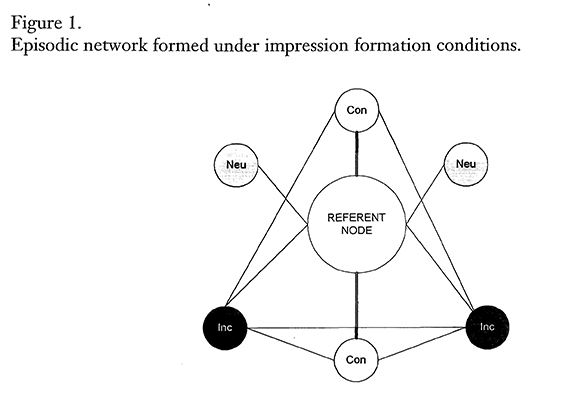
3. The retrieval processes underlying the free recall and the frequency estimation tasks depend on different aspects of the associative network. Namely, free recall depends on horizontal density (i.e., the number of horizontal links connecting each type of information with each other), and frequency estimation on vertical linkage strength (i.e., how strongly associated is the referent node with each type of information). Thus, the incongruency and the illusory correlation effects are not only compatdble, they can even emerge simultaneously from the responses of subjects who perform both tasks.
4. The retrieval process nnderlying frequency estimation is a selective and non-exhaustive search process, while the same process underlying free recall has the opposite features, that is, it non-selective and exhaustive (see Figures 2 and 3 ). The retrieval process underlying frequency estimation is selective because the available specific cues are used to narrow down the search. That is, if subjects are asked, for instance, «how many behaviors diagnostic of the trait x performed by target y have you been presented with?» the respective search is not going to be performed «blindly,» because «trait x» is going to be used as a cue, and only information related to this cue is going to be transferred to working memory. In addition, search under these conditions will not be exhaustive because retrieving a few relevant behavioral instances is sufficient to assess «ease of retrieval,» the main function of this retrieval process.
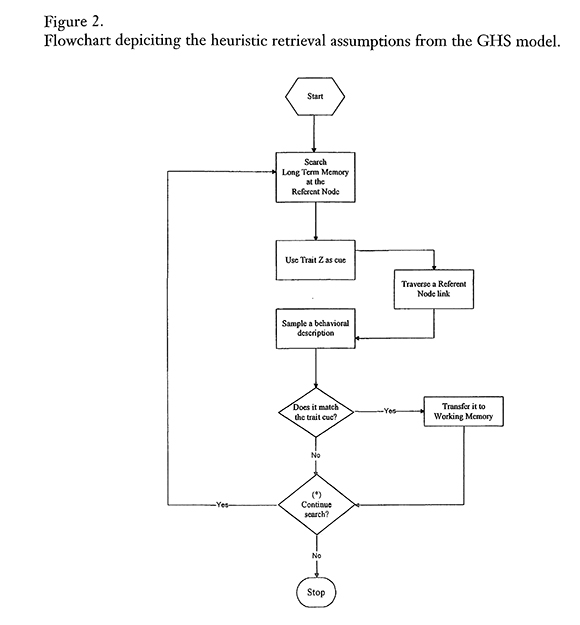
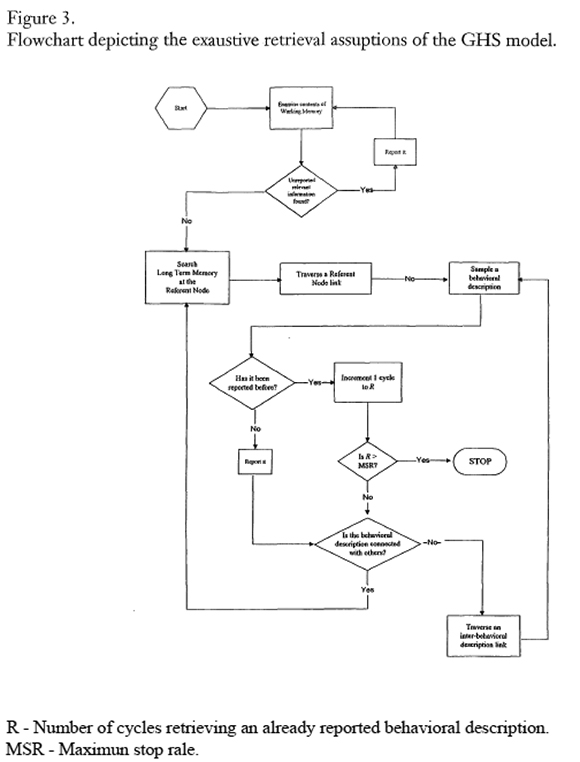
On the contrary, the retrieval process undelying free recall departs from the referent node and continues, blindly, by the horizontal links of the network, whenever possible, until the criterium specified by a «maximum stop» rule has been met.
Note that for frequency estimations, search is performed only along the vertical links. Resorting to horizontal links (something characteristic of an exhaustive search process) would not allow for an effective selective search because different types of information are often interconnected (e.g., expectancy-incongruent is directly linked with congruent information in impression formation conditions), and hence irrelevant information would often be retrieved.
5. As expectancy-congruent information is more strongly associated with the referent node than is incongruent information, the occurrence of the former type of information tends to be overestimated compared with the latter - the illusory correlation effect. On the other hand, as expectancy-incongruent is more densely inter-connected than both expectancy-congruent or expectancy-neutral information, its probability of being free recalled is higher - the incongruency effect.
6. Whenever a pre-computed impression judgment is not available or easily accessible, the computation of this type of judgment is based on a retrieval search process more akin to the one underlying frequency estimation than the one underlying free recall. Therefore, under these conditions, strong correlations should emerge in impression ratings.
In sum, I am proposing that incongruency and expectancy-based illusory correlations are not incompatible phenomena. On the contrary, they are typically obtained using memory measures (i.e., free recall and frequency estimation) that dependend on the different modes of search and retrieval. And thus, they can be dissociated in the sense of emerging simultaneously in the items free recalled and in the frequency estimates of the same subjects! An experiment testing these ideas will now be presented.
Method.
Subjects were asked either to form impressions about the targets or to remember the information to be presented. The information concerned the name and occupational group membership of two targets (two individuais or two groups), plus a booklet containing 36 behaviors (one per page) performed by them. From these 36 behaviors, 18 were attributed to each target (6 illustrative of a trait congruent with the occupational group membership, 6 illustrative of expectancy-incongruent traits, and 6 illustrative of expectancy-neutral traits. The stereotypes of each pair of targets always generated opposite trait expectancies. That is, while a librarian is supposedly cultured and boring, a waitress is supposedly uncultured and frui, on the other hand a cab driver is supposedly unambitious and fun and a Computer programmer is suposedly ambitious and boring. Traits and behaviors were selected by extensive pre-testing. Note that this characteristic of the stimulus materiais allowed me to attribute exactly the same behaviors to both groups of each pair (in different behavioral replication conditions). Thus, for instance, a given behavior illustrative of cultured personality wonld attributed to a librarian in one behavioral replication condition and to a waitress in another behvioral replication condition (it would be expectancycongruent in the first case, and expectancy-incongruent in the second).
After reading the behaviors, subjects were asked either to first free recall the behaviors and then to make frequencies estimates of the number of behaviors illustrative of each relevant trait performed by each target, or to perform these tasks in the opposite order (for the design). After completing both tasks, subjects were requested to make trait and likability judgments.
Results and discussion.
As the pattern of results was the same across Trait, Target and Behaviors replications, I collapsed across these variables, when possible.
Free Recall
Table 1 presents mean free recall (of the correctly attributed behavioral descriptions) as a function of the main independent variables of this experiment. A four-way ANOVA, 2 (Processing Goals) x 2 (Nature of Target) x 2 (Task Order) x 3 (Item Type: Congruent, Incongruent and Neutral), with repeated measures for the last factor, was computed. There were significant main effects for Nature of Target, F (1,152) = 31.87, p < .0001, showing that Individual Target behaviors (M = 3.76) were better recalled than Group Target behaviors (M = 2.52); Processing Goals, F (1,152) = 4.87, p < .03, reflecting the fact that behaviors learned under Impression Formation Goal conditions (M = 3.37) were recalled to a higher degree than behaviors learned under Memory Goal conditions (M = 2.88); and Item Type, F (2,304) = 9.26, p < .0001, revealing that Neutral behaviors (M = 2.71) were recalled to a lesser extent than both Congruent (3.22) and Incongruent (M = 3.45) behaviors. More important was that the fact that the predicted Processing Goals x Item Type interaction was significant, F (2,304) = 6.28, p < .003. Simple main effect analyses with post hoc Scheffé tests made clear the reasons for this interaction. Under Impression Formation Goal conditions, Incongruent behaviors (M = 3.99) were better recalled than both Congruent (M = 3.14) and Neutral behaviors (M = 2.93), F (2,158) = 8.72, p < .0004, whereas under Memory Goal conditions the number of Congruent behaviors recalled (M = 3.31) didn’t differ from the number of Incongruent behaviors (M = 2.91), both differing from the number of Neutral behaviors recalled (M = 2.42), F (2,158) = 6.74, p<.01.
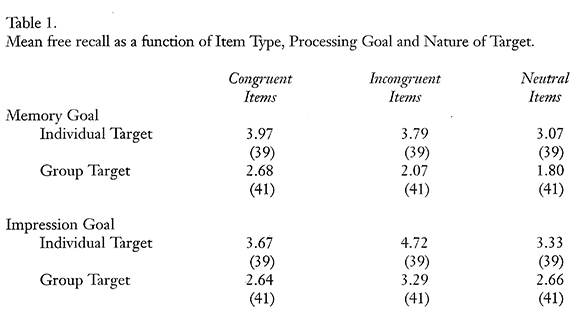
Thus three basic results commonly found in the literature have been replicated. Namely, the superior recall of impression formation conditions relative to memory instructional sets (see Hamilton, 1981b; Hamilton, Katz & Leirer, 1980a; 1980b; see also, Klein & Loftus, 1990), the lowest recall of expectancy-neutral information (e.g., Hastie and Kumar, 1979; Srull, 1981) and, of course, the incongruency effect. The better overall recall obtained in Individual Target conditions relative to Group Target conditions, though interesting, cannot be readily interpreted because Group Targets descriptions included a different first name for each behavior, and this fact alone could have been detrimental to its recall level.
Frequency Estimates
Figure 4 presents mean frequency estimates as a function of our main independent variables. A four-way ANOVA, 2 (Processing Goals) x 2 (Nature of the Target) x 2 (Task Order) x 2 (Item Type: Congruent or Incongruent), with repeated measures for the last factor, was computed. The only effect to emerge was a main effect for Item Type, F (1,150) = 22.41, p < .0001, reflecting the fact that Congruent Item occurrence was overestimated (M = 16.61), compared to Incongruent Item occurrence (M = 13.49). Remember that when behavioral replications are collapsed, Expectancy-congruent and incongruent items are the same (only group assignment is different).
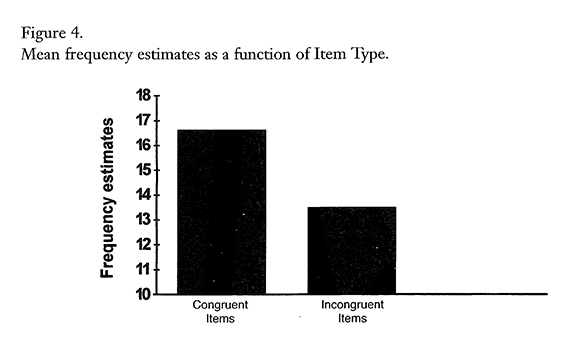
These results basically mean that the predicted illusory correlation effect was obtained and replicated for both Impression Formation and Memory Processing Goals, also for both Individual and Group Targets, and even when Congruent information is direcdy contrasted with Incongruent Information. Thus the generality of the effect has gready been enhanced. Furthermore, performing, immediately before making the frequency judgments, a free recall task with an incongmency biased outcome didn’t moderate the illusory correlation.
Impression Judgments
Figure 5 presents mean impression judgments as a function of the main independent variables. The Target variable aggregates Cab Drivers with Waitresses targets and Computer Programmers with Librarian targets. The trait dimensions are also collapsed in a way that if the trait judgments follow expectancies the Cab Drivers/Waitresses’ ratings should always be higher than Computer Programmers/Librarians ’ ones. A four-way ANOVA, 2 (Processing Goals) x 2 (Nature of Target) x 2 (Task Order) x 2 (Targets: Cab Drivers/ Waitresses or Computer Programmers/Librarian), with repeated measures for the last factor, was computed. A main effect emerged showing that Cab Drivers and Waitresses were judged as being either, depending on trait replication, more Funny (less Boring), more Unambitious (less Ambitious) or more Uncultured (less Cultured), with a mean trait rating of M = 5.84 than Computer Programmers and Librarians (M = 4.61), F (1,152) = 23.51, p < .0001. This result reflects, of course, an expectancy bias.
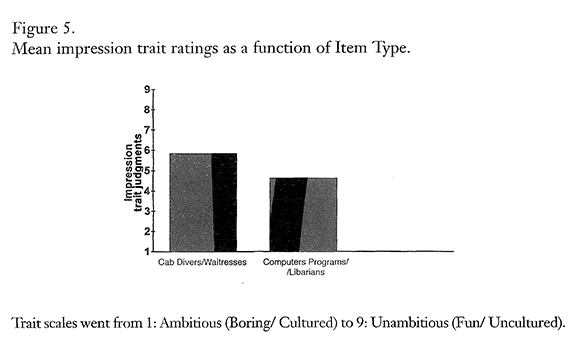
This result not only is highly consonant with the belief perseverance literature cited in the introduction but also mirrors the results obtained for frequency estimates.
The results of this experiment were indeed encouraging. The «Generalized Hastie-Srull» (GHS) model introduced earlier received considerable empirical support. The predicted dissociation between free recall and frequency estimates under Impression Formation conditions did occur. And this dissociation was found even when the frequency judgments were performed immediately after free recall.
The other effects of recall (higher overall recall of Impression Formation Goal relative to Memory Goal conditions, poorest recall of expectancy-neutral behaviors), validate the comparability of this new experimental paradigm to the Standard Hastie-Srull paradigm.
Analyses of the frequency judgment data revealed strong illusory correlation effects. This research extends previous findings, demonstrating this effect when Congruent and Incongruent information was presented in the same set, with different processing goals (memory and impression formation), and even when subjects were asked to judge implicitly referenced information (the behavior categories or traits).
In sum, these results (and further results obtained in other experiments, see Garcia-Marques, 1993) support the main contention of this paper: free recall and frequency estimation can be dissociated in terms of the effects of expectancies they reveal. Free recall protocols are produced by means of exhaustive and blind retrieval processes, and the impact of expectancies emerge with the form of incongruency effects. Frequency estimates derived from heuristic and selective memory search processes, and the impact of expectancies emerge with the form of illusory correlations. Note that, however, as exhaustive search is probably seldomly performed outside the laboratory, expectancy effects on jugdments are most likely to be congruency-biased! And thus, the incongruency effect can now hardly be taken as support for an image of the Human Being as a Popperian seeker of incongruency, in a State of perpetual cognitive change.
Incongruency and expectancy-based illusory correlations are, therefore, not only compatible, but they are even to be expected in the firamework of the GHS model. This constitutes an important incentive to further developments of this model.
References
Allport, G. W. (1954). The nature of prejudice. Reading, MA: Addison-Wesley. (Tenth printing: 1987.)
Anderson; N. H. & Hubert, S. (1963). Effects of concomitant verbal recall on order effects in personality impression formation. Journal of Verbal Learning and Verbal Behavior, 2, 379-391. [ Links ]
Asch, S. E. (1946). Forming impressions of personality. Journal of Abnormal and Social Psychology, 41, 258-290. [ Links ]
Braner, J. S. & Potter, M. (1964). Inference in visual recognition. Science, 144, 424-425. [ Links ]
Chapman, L. J. & Chapman, J. (1967). Genesis of popular but erroneous psychodiagnostic observations. Journal of Abnormal Psychology, 73, 193-204. Ilusory correlation as an obstacle to the use of valid psychodiagnostic signs. Journal of Abnormal Psychology, 74, 271-280. [ Links ]
Chapman, L. J. & Chapman, J. (1971). Test results are what you think they are. Psychology Today, pp. 18-22, 106-10. [ Links ]
Crocker, J., Hannah, D. B. & Weber, R. (1983). Person memory and causal attribution. Journal of Personality and Social Psychology, 44, 55-66. [ Links ]
Festinger, L. (1957). A theory of cognitive dissonance. Paio Alto, CA: Stanford University Press.
Fiske, S. T. & Neuberg, S. L. (1990). A continuum of impression formation, from category-based to individuating processes: Influences of information and motivation on attention and interpreta tion. In M. P. Zanna (Ed.), Advances in Experimental Social Psychology (Vol. 23, pp. 1-74). New York, NY: Academic Press.
Garcia-Marques, L. (1993). The Importance of Being Incongruent: How memorable will an uncultured lihrarian be? Towards the resolution of the apparent discrepancy between expectancy-based illusory correlations and incongruency effects. Non published dissertation. Faculdade de Psicologia e Ciências da Educação, Universidade de Lisboa.
Hamilton, D. L. (1981). Illusory correlation as a basis for stereotyping. In D. L. Hamilton (Ed.), Cognitive processes in stereotyping and intergroup behavior (pp. 115144). Hillsdale, NJ: Lawrence Erlbauim
Hamilton, D. L., Katz, L. & Leirer, V (1980a). Cognitive representation of personality impressions: Organizational processes in first impressions formation. Journal of Personality and Social Psychology 39, 1050-1063. [ Links ]
Hamilton, D. L., Katz, L. & Leirer, V (1980b). Organizational processes in impression formation. In R. Hastie, T. M. Ostrom, E. B. Ebbesen, R. S. Wyer, Jr., D. L. Hamilton & D. E. Carlston (Eds.), Person Memog (pp. 121-153). Hillsdale, NJ: Lawrence Erlbaum.
Hastie, R. & Kumar, A. P. (1979). Person memory: Personality traits as organizing principles in memory for behaviors. Journal of Personality and Social Psychology, 37, 25-38. [ Links ]
Higgins, E. T. & Bargh, J. A. (1987). Social cognition and social perception. Annual Review of Hamilton, D. L., Katz, L. & Leirer, V 38, 369-425. [ Links ]
Klein, S. B. & Loftus, J. (1990). Rethinking the role of organization in person memory: An independent trace storage model. Journal of Personality and Social Psychology, 59, 400-410. [ Links ]
Mynatt, C. R., Doherty, M. E. & Tweeney, R. D. (1977). Confirmation bias in a simulated research environment: An experimental study of scientific inference. Quartely Journal of Experimental Psychology, 29, 85-95. [ Links ]
Rojahn, K. & Pettigrew, T. F. (1992). Memory for schema-revelant information: A metaanalytic resolution. British Journal of Social Psychology, 31, 81-110. [ Links ]
Rummelhart, D. E. & Ortony, A. (1977). The representation of knowledge in memory. In R. C. Anderson, R. J. Spiro & W. E. Montague (Eds.), Shooling and the acquisition of knowledge (pp. 99-136). Hiilsdale, NJ: Lawrence Erlbaum.
Srall, T. K. (1981). Person memory: Some tests of associative storage and retrieval models. Journal of Experimental Psychology: Human Learning and Cognition, 7, 440-462. [ Links ]
Srall, T. K. & Wyer, R. S., Jr. (1989). Person memory and judgment. Psychological Review, 96, 58-83. [ Links ]
Stangor, C. & McMillan, D. (1992). Memory for expectancy-congraent and expectancyincongraent information: A review of the social and developmental literatures. Psychological Bulletin, 111, 42-61. [ Links ]
Stangor, C. & Ruble, D. N. (1989). Strength of expectancies and memory for social information: What we remember depends on how much we know. Journal of Experimental Social Psychology, 25, 18-35. [ Links ]
Wason, P. C. & Johnson-Laird, P. N. (1972). Psychology of reasoning: Structure and content. London: Batsford. [ Links ]
Wyer, R. S., Jr. (1989). Social memory and social judgment. In P. R. Solomon, G. R. Goethals, C. M. Kelley & B. R. Stephens (Eds.), Memory: Interdisciplinary approaches (pp. 243-242). New York, NY: Lawrence Erlbaum.
Wyer, R. S. & Srall, T. K. (1986). Human cognition in its social context. Psychological Review, 93, 322-359. [ Links ]
Wyer, R. S. & Srall, T. K. (1989). Memory and cognition in its social context. Hiilsdale, NJ: Lawrence Erlbaum.














